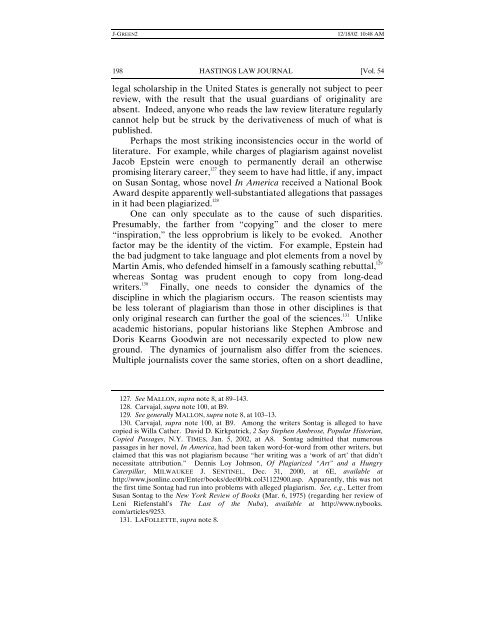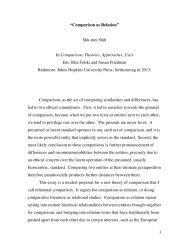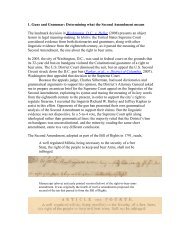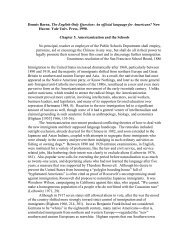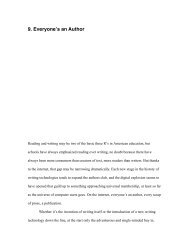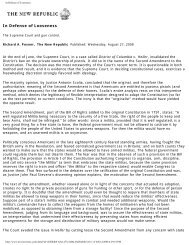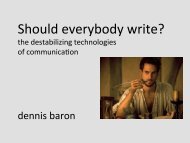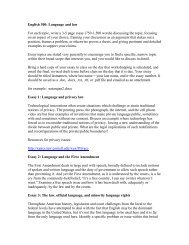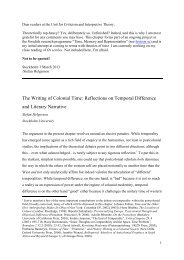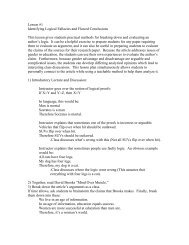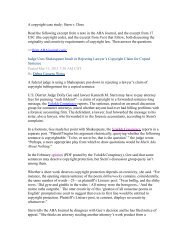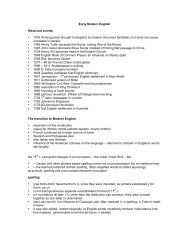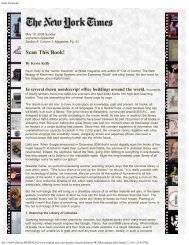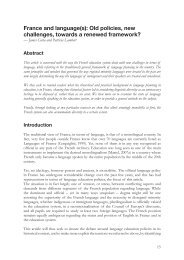Plagiarism, Norms, and the Limits of Theft Law: Some ... - English
Plagiarism, Norms, and the Limits of Theft Law: Some ... - English
Plagiarism, Norms, and the Limits of Theft Law: Some ... - English
You also want an ePaper? Increase the reach of your titles
YUMPU automatically turns print PDFs into web optimized ePapers that Google loves.
J-GREEN2 12/18/02 10:48 AM<br />
198 HASTINGS LAW JOURNAL [Vol. 54<br />
legal scholarship in <strong>the</strong> United States is generally not subject to peer<br />
review, with <strong>the</strong> result that <strong>the</strong> usual guardians <strong>of</strong> originality are<br />
absent. Indeed, anyone who reads <strong>the</strong> law review literature regularly<br />
cannot help but be struck by <strong>the</strong> derivativeness <strong>of</strong> much <strong>of</strong> what is<br />
published.<br />
Perhaps <strong>the</strong> most striking inconsistencies occur in <strong>the</strong> world <strong>of</strong><br />
literature. For example, while charges <strong>of</strong> plagiarism against novelist<br />
Jacob Epstein were enough to permanently derail an o<strong>the</strong>rwise<br />
promising literary career, 127 <strong>the</strong>y seem to have had little, if any, impact<br />
on Susan Sontag, whose novel In America received a National Book<br />
Award despite apparently well-substantiated allegations that passages<br />
in it had been plagiarized. 128<br />
One can only speculate as to <strong>the</strong> cause <strong>of</strong> such disparities.<br />
Presumably, <strong>the</strong> far<strong>the</strong>r from “copying” <strong>and</strong> <strong>the</strong> closer to mere<br />
“inspiration,” <strong>the</strong> less opprobrium is likely to be evoked. Ano<strong>the</strong>r<br />
factor may be <strong>the</strong> identity <strong>of</strong> <strong>the</strong> victim. For example, Epstein had<br />
<strong>the</strong> bad judgment to take language <strong>and</strong> plot elements from a novel by<br />
Martin Amis, who defended himself in a famously scathing rebuttal, 129<br />
whereas Sontag was prudent enough to copy from long-dead<br />
writers. 130 Finally, one needs to consider <strong>the</strong> dynamics <strong>of</strong> <strong>the</strong><br />
discipline in which <strong>the</strong> plagiarism occurs. The reason scientists may<br />
be less tolerant <strong>of</strong> plagiarism than those in o<strong>the</strong>r disciplines is that<br />
only original research can fur<strong>the</strong>r <strong>the</strong> goal <strong>of</strong> <strong>the</strong> sciences. 131 Unlike<br />
academic historians, popular historians like Stephen Ambrose <strong>and</strong><br />
Doris Kearns Goodwin are not necessarily expected to plow new<br />
ground. The dynamics <strong>of</strong> journalism also differ from <strong>the</strong> sciences.<br />
Multiple journalists cover <strong>the</strong> same stories, <strong>of</strong>ten on a short deadline,<br />
127. See MALLON, supra note 8, at 89–143.<br />
128. Carvajal, supra note 100, at B9.<br />
129. See generally MALLON, supra note 8, at 103–13.<br />
130. Carvajal, supra note 100, at B9. Among <strong>the</strong> writers Sontag is alleged to have<br />
copied is Willa Ca<strong>the</strong>r. David D. Kirkpatrick, 2 Say Stephen Ambrose, Popular Historian,<br />
Copied Passages, N.Y. TIMES, Jan. 5, 2002, at A8. Sontag admitted that numerous<br />
passages in her novel, In America, had been taken word-for-word from o<strong>the</strong>r writers, but<br />
claimed that this was not plagiarism because “her writing was a ‘work <strong>of</strong> art’ that didn’t<br />
necessitate attribution.” Dennis Loy Johnson, Of Plagiarized “Art” <strong>and</strong> a Hungry<br />
Caterpillar, MILWAUKEE J. SENTINEL, Dec. 31, 2000, at 6E, available at<br />
http://www.jsonline.com/Enter/books/dec00/bk.col31122900.asp. Apparently, this was not<br />
<strong>the</strong> first time Sontag had run into problems with alleged plagiarism. See, e.g., Letter from<br />
Susan Sontag to <strong>the</strong> New York Review <strong>of</strong> Books (Mar. 6, 1975) (regarding her review <strong>of</strong><br />
Leni Riefenstahl’s The Last <strong>of</strong> <strong>the</strong> Nuba), available at http://www.nybooks.<br />
com/articles/9253.<br />
131. LAFOLLETTE, supra note 8.


